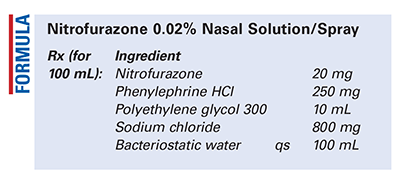US Pharm. 2018;43(4):46-47.

Method of Preparation: Calculate the quantity of each ingredient for the amount to be prepared. Accurately weigh or measure each ingredient. Dissolve the nitrofurazone in the polyethylene glycol 300. Dissolve the phenylephrine hydrochloride (HCl) and sodium chloride in the bacteriostatic water. Combine the two liquids and add sufficient bacteriostatic water to final volume; then mix well. Package in a light-resistant nasal spray container and label.
Use: Nitrofurazone nasal solution has been used in the treatment of nasal infections.
Packaging: Package in light-resistant nasal dropper or spray containers.
Labeling: Keep out of reach of children. Use only as directed. Protect from light. Discard after ____ [time period].
Stability: A beyond-use date of up to 30 days may be used for this preparation.1
Quality Control: Quality-control assessment can include weight/volume, pH, specific gravity, active drug assay, color, clarity, rheologic properties, physical observation, and physical stability (discoloration, foreign materials, gas formation, mold growth).2
Discussion: Nitrofurazone is bactericidal for most pathogens that commonly cause surface skin infections, including Staphylococcus aureus, Streptococcus, Escherichia coli, Clostridium perfringens, Enterobacter aerogenes, and Proteus organisms. For the treatment of burns, topical nitrofurazone is indicated as an adjunctive therapy for second- and third-degree burns when resistance to other agents is a real or potential problem. For skin infections, nitrofurazone is indicated in skin grafting when bacterial contamination may cause graft rejection or donor-site infection, especially in hospitals with a history of resistant bacteria. Furacin Topical Solution contains 0.2% nitrofurazone, octoxynol 9, polyethylene glycol 400, polyethylene glycol 4000, and purified water.
Nitrofurazone (Furacin, C6H6N4O4, MW 198.14) is a topical anti-infective that occurs as a lemon-yellow, odorless, crystalline powder that darkens slowly upon exposure to light. It melts at about 236°C with decomposition and is slightly soluble in propylene glycol and in polyethylene glycol mixtures. Nitrofurazone is very slightly soluble in alcohol and in water. Official preparations include Nitrofurazone Ointment USP and Nitrofurazone Topical Solution USP.1
Phenylephrine HCl (Neo-Synephrine, C9H13NO2.HCl, MW 203.67) is a sympathomimetic amine that predominantly acts by a direct effect on alpha-adrenergic receptors. It occurs as white or practically white, odorless crystals with a bitter taste, and it is freely soluble in water and in alcohol.1
Polyethylene glycol 300 (Carbowax, PEG, polyoxyethylene glycol) is an addition polymer of ethylene oxide and water. It occurs as a clear, colorless or slightly yellow-colored, viscous liquid with a slight but characteristic odor and a bitter, slightly burning taste. It has a density in the range of 1.11 to 1.14 g mL and a freezing point of –15°C to –8°C. Polyethylene glycol 300 is soluble in water and miscible in all ratios with other polyethylene glycols. It is also soluble in acetone, alcohols, glycerin, and glycols.3
Sodium chloride (NaCl, MW 58.44) is available as a white, crystalline powder or as colorless crystals. It has a saline taste and is used in a variety of parenteral and nonparenteral pharmaceutical formulations. In parenteral, ophthalmic, and nasal preparations, sodium chloride is used to prepare isotonic solutions. It is also used as a capsule diluent, as a lubricant, to control drug release from some microcapsules, to control micelle size, and to adjust the viscosity of some polymer dispersions by altering the ionic character of the formulation. The pH of a saturated solution is in the range of 6.7 to 7.3, and it is soluble in water (1 g in 2.8 mL), glycerin (1 g in 10 mL), and 95% ethanol (1 g in 250 mL). A 0.9% w/v aqueous solution is isoosmotic with serum, and its solutions are stable.4
Bacteriostatic water is purified water USP to which a preservative has been added. An example formula would contain methylparaben (500 mg), propylparaben (250 mg), and sufficient purified water (distilled water, deionized water, reverse-osmosis water) to make 1,000 mL. Heat may be used to assist in the dissolution of the parabens.
REFERENCES
1. U.S. Pharmacopeia/National Formulary [current revision]. Rockville, MD: U.S. Pharmacopeial Convention, Inc; March 2018.
2. Allen LV Jr. Standard operating procedure for performing physical quality assessment of oral and topical liquids. IJPC. 1999;3:146-147.
3. Wallick D. Polyethylene glycol. In: Rowe RC, Sheskey PJ, Quinn ME, eds. Handbook of Pharmaceutical Excipients. 6th ed. London, England: Pharmaceutical Press; 2009:517-522.
4. Maximilien JS. Sodium chloride. In: Rowe RC, Sheskey PJ, Cook WG, Fenton ME, eds. Handbook of Pharmaceutical Excipients. 7th ed. London, England: Pharmaceutical Press; 2012:729-732.
To comment on this article, contact rdavidson@uspharmacist.com.






